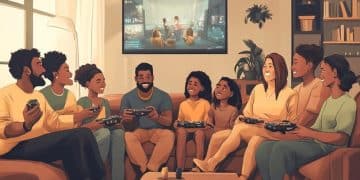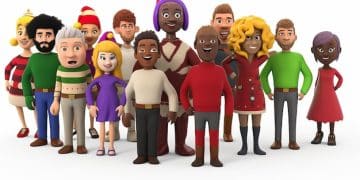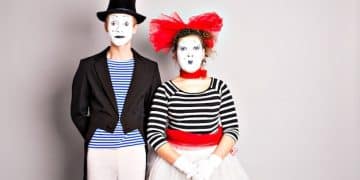Reality TV & Fashion: How Shows Influence Your Style Choices
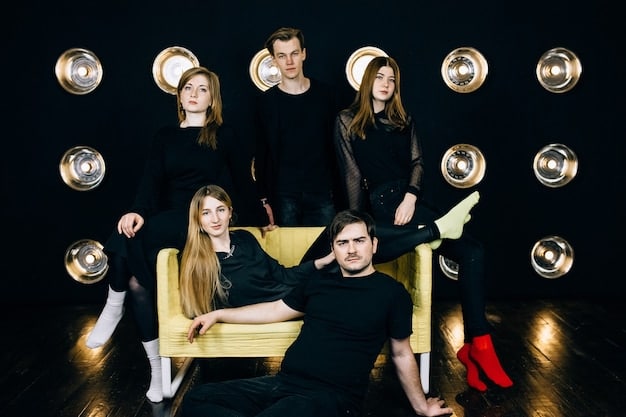
Reality TV’s influence on fashion trends is undeniable, with shows shaping consumer choices by showcasing aspirational styles, driving immediate purchasing decisions, and setting long-term fashion trends.
Have you ever wondered where that must-have outfit you just saw on Instagram came from? Chances are, its origins trace back to the small screen and reality TV’s influence on fashion trends: how shows shape consumer choices is more profound than you might think.
The Rise of Reality TV and Its Cultural Impact
Reality TV has evolved from a niche genre to a dominant force in popular culture. Its impact extends far beyond entertainment, influencing how we perceive ourselves and the world around us.
From showcasing lavish lifestyles to highlighting everyday struggles, reality shows offer a glimpse into different facets of life, captivating audiences and shaping their aspirations.
The Evolution of Reality TV
The reality TV landscape has transformed drastically over the years. What started with simple documentaries has grown into a multi-billion dollar industry with diverse formats.
- Early Reality TV: Shows like “The Real World” and “Survivor” paved the way, experimenting with unscripted drama and real-life challenges.
- Competition Shows: “American Idol” and “The Amazing Race” amplified the stakes, blending talent showcases with high-pressure competition.
- Lifestyle and Luxury: Programs like “Keeping Up with the Kardashians” and “The Real Housewives” franchises ushered in a new era of aspirational living and conspicuous consumption.
This evolution has not only transformed television but also how we interact with media and perceive celebrity culture.
Fashion as a Character: How Wardrobe Tells a Story
On reality TV, fashion is more than just clothing; it’s a character in itself. The outfits worn by cast members communicate personality, status, and intentions.
Producers and stylists carefully curate wardrobes to enhance the storytelling, making each outfit choice a deliberate decision that can shape viewer perceptions.
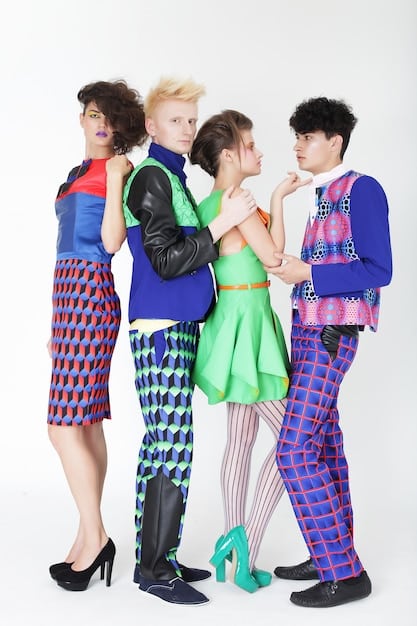
Styling for Success: The Role of Wardrobe
The wardrobe on a reality show is carefully considered, from the selection of pieces to the coordination of looks. Stylists work to create a visual narrative that supports the show’s storylines.
- Building Character: Outfits often reflect a character’s personality traits. For example, a business-savvy contestant might be styled in sharp, professional attire.
- Creating Visual Interest: Diverse wardrobes add visual appeal, keeping viewers engaged.
- Enhancing Drama: Fashion choices can amplify conflicts and plot twists. A bold outfit worn during a tense moment can heighten the drama.
Fashion, therefore, plays a pivotal role in shaping the overall narrative and emotional impact of reality TV.
The “See Now, Buy Now” Effect: Fast Fashion’s New Frontier
The “see now, buy now” phenomenon has found fertile ground. As viewers watch their favorite shows, they’re immediately exposed to new fashion trends. This immediacy drives purchasing decisions.
Social media platforms amplify this effect, with viewers posting about outfits they admire and seeking out similar styles online.
The Power of Social Media
Social media has blurred the lines between the screen and reality. It used to take months for a trend to go mainstream. Nowadays viewers can spot an outfit on TV, find it online using reverse image search, and purchase it within minutes.
- Instant Gratification: Social media platforms enable viewers to instantly share and seek out fashion inspiration.
- Influencer Marketing: Reality TV stars often become influencers, promoting brands and products to their followers and driving sales.
- Visual Discovery: Platforms like Pinterest and Instagram allow users to visually explore fashion trends, making it easier to replicate celebrity styles.
This convergence of technology and media has created a continuous feedback loop that propels trends forward at unprecedented speed.
From Catwalk to Couch: High Fashion’s Democratization
The influence of reality TV has also democratized high fashion, bringing designer styles and trends to a wider audience.
Luxury brands are increasingly collaborating with reality TV stars, leveraging their mass appeal to reach new consumers, creating a blend of high and low fashion.
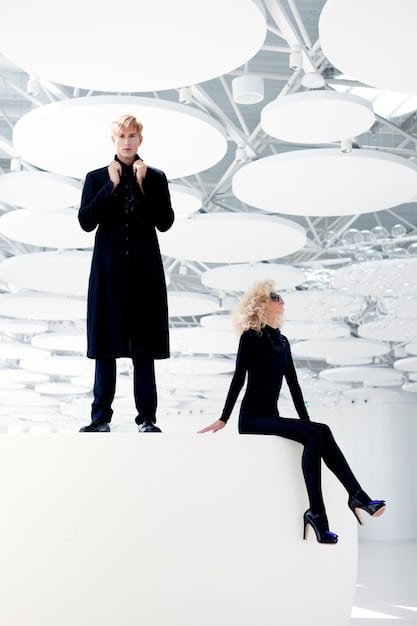
Reality Stars as Style Ambassadors
Reality stars are becoming ambassadors for high-fashion brands. Brands seek celebrity endorsements to boost visibility and align with aspirational lifestyles.
By wearing designer items, reality TV personalities can increase brand awareness and drive sales among their followers. Some brands are even tapping these figures to create limited-edition collections.
The phenomenon has redefined brand strategy, making runway fashion more accessible and relatable to viewers.
The Lasting Impact: Shaping Long-Term Fashion Trends
Reality TV does more than create fleeting trends; it shapes long-term fashion sensibilities. Recurring styles and aesthetics showcased on popular shows influence what we consider fashionable for years to come.
Shows set new standards and create style movements that permeate mainstream culture, influencing everything from streetwear to formal wear.
The Enduring Influence
The ongoing impact of reality TV on fashion is evident in the way shows can revive forgotten styles or introduce new aesthetics that become cultural staples.
- Reviving Vintage: Shows such as “RuPaul’s Drag Race” have brought back vintage aesthetics.
- Setting Standards: The show “Queer Eye” has set new standards for men’s grooming and fashion.
- Influencing Design: Emerging themes and styles often influence designers and stylists.
Today, the fashion shown on reality shows continues to shape the way that fashion trends evolve over time.
Criticisms and Considerations: The Dark Side of the Trend
While the influence of reality TV on fashion is undeniable, it’s equally important to acknowledge the criticisms and potential downsides.
The promotion of consumerism and the perpetuation of unrealistic beauty standards are among the main concerns.
The Consumerism Conundrum
Some people believe that reality shows encourage overconsumption and promote an unsustainable approach to fashion. They say that since reality shows are always advertising new brands and styles, that can lead to increased spending.
- Unsustainable Consumption: The pressure to replicate high fashion trends can lead to disposable fast fashion.
- Unrealistic Standards: The lifestyles on many reality shows can promote unattainable lifestyles.
- Ethical Issues: Some of the brands that reality show stars promote have unethical production and labor practices.
Viewers should be critical of the consumer culture promoted on reality TV and make informed and ethical choices in their fashion consumption.
| Key Point | Brief Description |
|---|---|
| 📺 Rise of Reality TV | Became a dominant force in popular culture influencing lifestyle aspirations. |
| 👗 Fashion as Character | Wardrobe tells stories on TV shows shaping viewer perceptions and storylines. |
| 🛍️ See Now, Buy Now | Viewers can instantly find and purchase outfits seen on reality TV through social media. |
| 💸 Consumerism Concerns | Increased consumerism and its impact on social media. |
FAQ
▼
Reality TV shows influence fashion trends by showcasing specific styles and outfits worn by cast, which viewers then seek to emulate. This immediate exposure drives fast purchasing decisions.
▼
The “see now, buy now” effect is when audiences watch their favorite television shows and see stylish items immediately. They then either immediately search to buy them or something similar.
▼
Reality TV brings high fashion to a wider audience by featuring luxury brands and collaborations with stars. That can cause luxury fashion to become more accessible, relatable, and popular.
▼
Criticisms include promoting consumerism, unsustainable fast fashion, and unethical brands. These can all encourage unrealistic standards. Being cognizant of these impacts is very important.
▼
Social media platforms enable viewers to instantly spot, share, and purchase fashion items seen on reality TV. Influencer marketing also fuels product endorsements and trends, creating more sales.
Conclusion
The influence of reality TV on fashion is pervasive and multifaceted. From setting immediate trends to democratizing high fashion and shaping long-term style sensibilities, the impact of reality shows on what we wear every day is undeniable. However, viewers should remain critical and mindful of the consumerist undertones and make responsible shopping choices.
